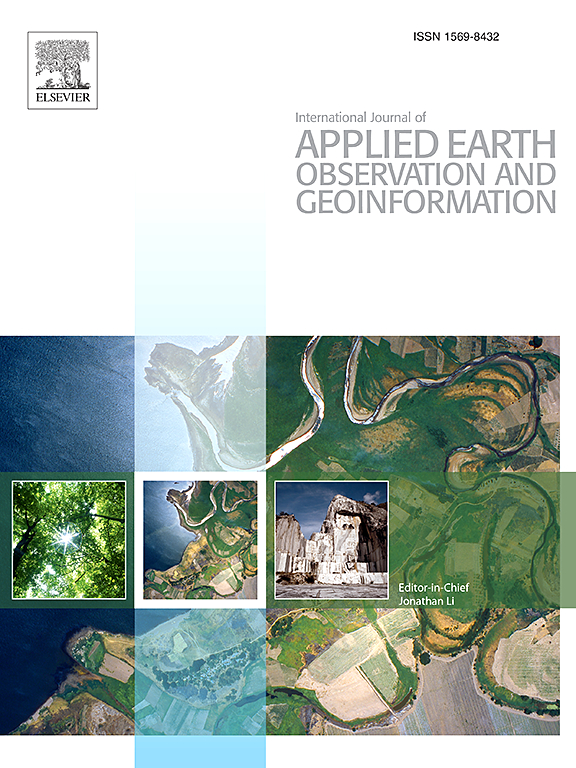Inversion of snow geophysical parameters using the VHR PAZ X-band dual polarimetric SAR data: first known experiments in the Himalayan region
IF 8.6
Q1 REMOTE SENSING
International journal of applied earth observation and geoinformation : ITC journal
Pub Date : 2025-06-09
DOI:10.1016/j.jag.2025.104653
引用次数: 0
Abstract
Snow plays a vital role in mountain hydrology, water resources, and Earth’s planetary budgets. Therefore, monitoring snow geophysical parameters (SGPs), such as snow density, Snow depth (SD), and snow water equivalent (SWE), is imperative hydrological dynamics and forecasting water availability. Moreover, radar remote sensing offers significant capabilities for estimating these parameters. In this study, we utilized PAZ X-band dual-polarimetric data to estimate SGPs. To the best of our knowledge, this is the first known experiment using PAZ data for SGP estimation. In the present work, we utilized the copolar phase difference (CPD) for SD and Integral Equation model (IEM) for snow density. In this study, we proposed an improved algorithm for SD inversion, instead of relying on a single in-situ snow density value, we incorporated a range of snow densities (0.15 to 0.27 g/cm3), optimizing the axial ratio between 1.13 and 1.17. This density range and optimized axial ratio were used to minimise the error between and the average . The algorithm yielded high-resolution modelled SD and density at a 2.5 m spatial resolution, which were later used to estimate SWE. Algorithm validation was performed using in-situ data of Gulmarg region of Kashmir, India, with statistical metrics such as mean absolute error (MAE), root mean square error (RMSE), coefficient of determination (R2), and percentage error (PE). SD estimates showed high correlation, with R2 = 0.85, RMSE = 3.18 cm, PE = 1 %, and MAE = 2.85 cm. Similarly, SWE estimates had an R2 of 0.77, RMSE = 1.032 cm, PE = 5 %, and MAE = 0.814 cm, demonstrating the model’s accuracy and reliability.
利用VHR PAZ x波段双偏振SAR数据反演雪地球物理参数:喜马拉雅地区的首次实验
雪在山地水文、水资源和地球的行星预算中起着至关重要的作用。因此,监测雪的地球物理参数(SGPs),如雪密度、雪深(SD)和雪水当量(SWE),是水文动力学和水可用性预测的必要条件。此外,雷达遥感为估计这些参数提供了重要的能力。在这项研究中,我们利用PAZ x波段双偏振数据来估计SGPs。据我们所知,这是已知的第一个使用PAZ数据进行SGP估计的实验。在本研究中,我们使用了共极性相位差(CPD)和积分方程模型(IEM)来计算雪密度。在本研究中,我们提出了一种改进的SD反演算法,不再依赖单一的原位雪密度值,而是纳入一系列雪密度(0.15 ~ 0.27 g/cm3),优化轴向比在1.13 ~ 1.17之间。该密度范围和优化轴比用于最小化cpdob与平均CPDMod之间的误差。该算法产生高分辨率的模型SD和2.5 m空间分辨率的密度,随后用于估计SWE。利用印度克什米尔Gulmarg地区的现场数据,采用平均绝对误差(MAE)、均方根误差(RMSE)、决定系数(R2)和百分比误差(PE)等统计指标对算法进行验证。SD估计显示高度相关,R2 = 0.85, RMSE = 3.18 cm, PE = 1%, MAE = 2.85 cm。同样,SWE估计的R2为0.77,RMSE = 1.032 cm, PE = 5%, MAE = 0.814 cm,表明模型的准确性和可靠性。
本文章由计算机程序翻译,如有差异,请以英文原文为准。
求助全文
约1分钟内获得全文
求助全文
来源期刊

International journal of applied earth observation and geoinformation : ITC journal
Global and Planetary Change, Management, Monitoring, Policy and Law, Earth-Surface Processes, Computers in Earth Sciences
CiteScore
12.00
自引率
0.00%
发文量
0
审稿时长
77 days
期刊介绍:
The International Journal of Applied Earth Observation and Geoinformation publishes original papers that utilize earth observation data for natural resource and environmental inventory and management. These data primarily originate from remote sensing platforms, including satellites and aircraft, supplemented by surface and subsurface measurements. Addressing natural resources such as forests, agricultural land, soils, and water, as well as environmental concerns like biodiversity, land degradation, and hazards, the journal explores conceptual and data-driven approaches. It covers geoinformation themes like capturing, databasing, visualization, interpretation, data quality, and spatial uncertainty.
 求助内容:
求助内容: 应助结果提醒方式:
应助结果提醒方式:


